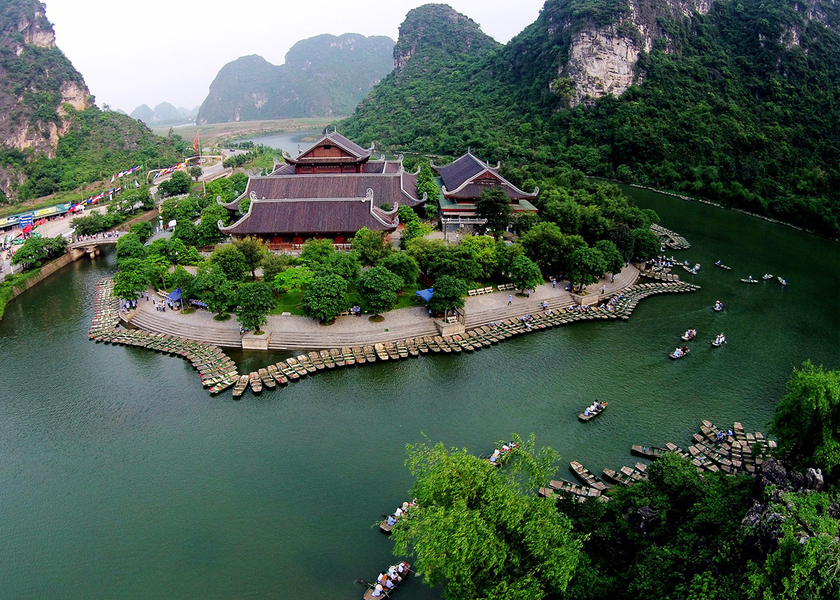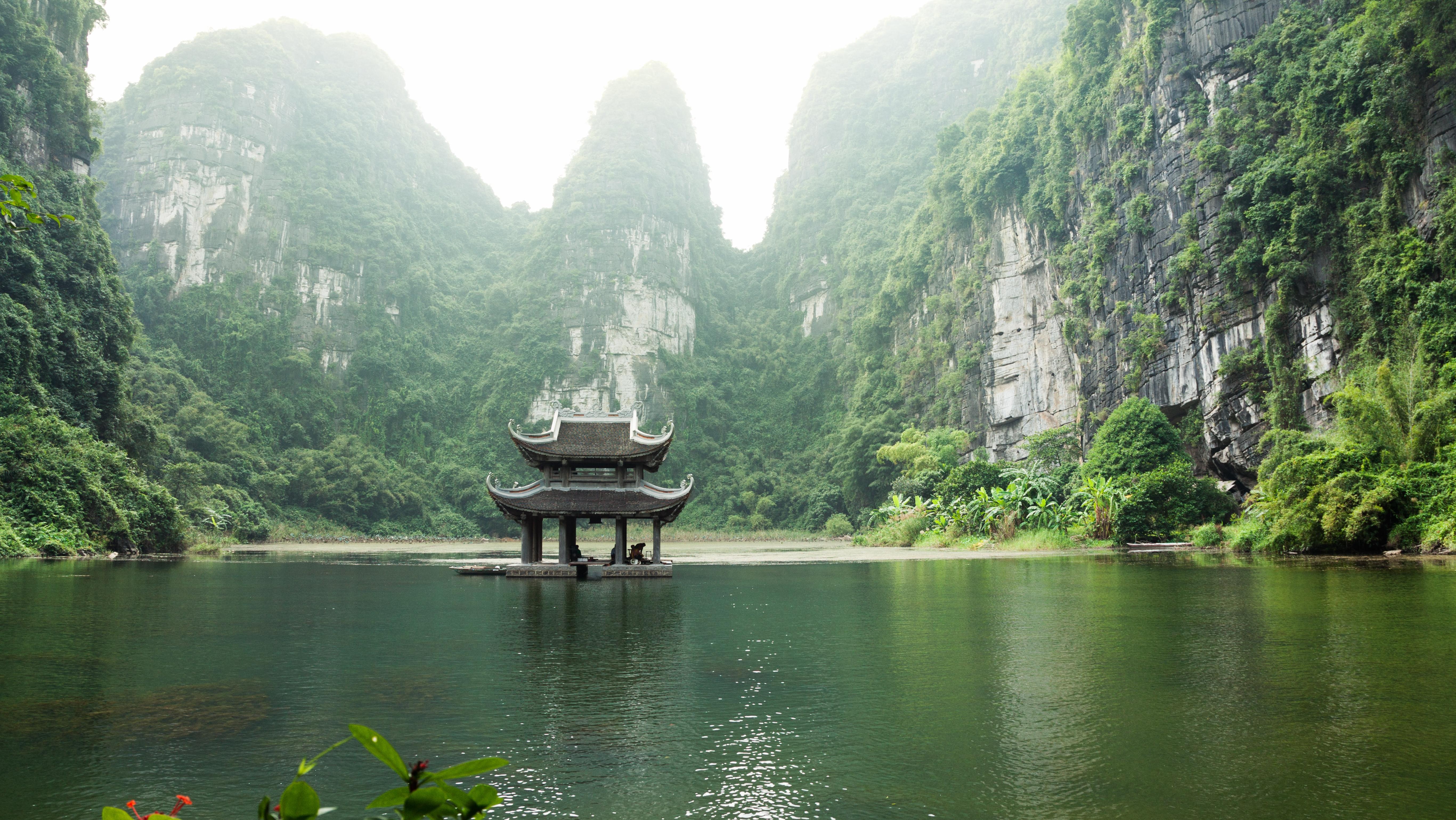Trang An heritage site and scenic complex is located on the southern edge of the Red River Delta in Ninh Binh province, with an area of 6,226 hectares and a buffer zone of 6,026 hectares, in the districts of Hoa Lu, Gia Vien, Nho Quan and Tam Diep city, Ninh Binh.
The heritage site consists of three protected areas: Hoa Lu Ancient Capital Historical and Cultural Relic Site, Trang An - Tam Coc - Bich Dong Scenic Area and Hoa Lu Special-Use Forest; containing all the unique landscape values and related cultural values. According to statistics, there are currently more than 20,000 people living in the core area of the heritage site.
On June 25, 2014, Trang An Scenic Landscape Complex was recognized by UNESCO as a World Cultural and Natural Heritage. This is the first mixed world heritage site in Vietnam and Southeast Asia with evidence of ancient people's interaction with the natural landscape and their efforts to adapt to environmental events over more than 30,000 years.

According to UNESCO experts, the work of preserving the value of Trang An world heritage site in association with sustainable development has had a relatively good balance - Photo: VGP/Diep Anh
The Trang An Scenic Landscape Complex heritage site also plays an important role in the religious life of not only local people but also people from other regions. Pilgrims account for the majority of visitors to the heritage site, especially during festivals, the number of visitors can reach 35,000 visitors/day. With its unique and special value in terms of landscape, culture and history at the human level, Trang An plays an important role in the socio-economic development of Ninh Binh province, creating the position and strength to turn Ninh Binh into a major tourist center of Vietnam, attracting a large number of domestic and international tourists to visit every year.
The average growth rate of visitors to Ninh Binh in the period 2010 - 2019 reached over 11%/year. In 2019, the whole province welcomed nearly 7.65 million visitors, of which domestic visitors were 6.58 million and international visitors were 970,000. Tourism revenue reached over 3,600 billion VND. Particularly, tourist areas and spots in the core heritage area welcomed over 3.1 million visitors in 2019, of which international visitors were about 650,000, with a growth rate of about 9.7%/year.
Tourism, service and heritage conservation activities have brought direct income and benefits to local people, thereby creating a close and cohesive relationship between the community and heritage, raising awareness and responsibility of each person, ensuring harmony between preserving natural landscapes, preserving and promoting heritage values and developing tourism.
According to the assessment of UNESCO experts, the work of preserving the value of Trang An world heritage associated with sustainable development has had a relatively good balance, harmony between environmental protection, state management, people and businesses. The policy and strategy of sustainable development associated with ensuring livelihoods for people has changed the face of many localities in the heritage site, transforming the economic structure from agriculture to tourism services, many traditional crafts have been restored, many new occupations and new livelihoods have been created, especially there has been a connection between tourism activities with agriculture and people's life experiences.
Security, order and environmental sanitation are ensured, technical facilities are always invested and upgraded; culture and tourism civilization have been improved, the quality of human resources and service and reception of tourists have basically been put into order; tourism promotion work is always focused on, the image and tourism brand of tourist areas and spots in Trang An Scenic Landscape Complex are increasingly affirmed.
The UNESCO Heritage title has truly played a role as the nucleus, the center for promoting tourism development in the whole province, affirming the position of Ninh Binh tourism in the domestic and international tourism market. Activities to promote Heritage values associated with tourism development in the direction of green growth in the Trang An Scenic Landscape Complex have been carried out quite well, demonstrated through the participation of local communities in livelihood activities related to tourism services, promoting the value of heritage.
Recently, at the International Conference on Promoting the Value of UNESCO Titles for Sustainable Development in Vietnam held in Ninh Binh, Mr. Michel Croft, Acting Head of UNESCO Office in Hanoi, said that he has followed and witnessed the achievements of the public-private partnership model in Ninh Binh since the first years of Ninh Binh province building the title for heritage. This is a very successful lesson of Ninh Binh when effectively calling for the attention and participation of many public and private sector partners in building and sustainably maintaining the conservation and promotion of the values of recognized world heritages, which can be applied to many other world heritage sites in Vietnam.
Mr. Firmin Edouard Matoko, Assistant Director-General of UNESCO for African Priorities and External Relations, said that to promote the value of UNESCO titles, there must be very specific mechanisms and policies for urban areas, thereby developing the economy while preserving and promoting the value of heritage. People need jobs, especially the young generation, so policies need to be applied differently between urban and rural areas.
Not a small challenge for Trang An to develop sustainably
However, in addition to the achievements, Trang An Heritage still faces many challenges to develop sustainably, becoming an attractive destination for regional and international tourism. That is, to harmoniously resolve the issue between heritage conservation and socio-economic development.
Currently, the number of tourists visiting the areas and tourist attractions in the Heritage area is increasing rapidly, leading to a high demand for tourist accommodation, especially in areas with natural landscapes and interspersed residential areas; the type of spontaneous homestay accommodation is increasing rapidly, mainly concentrated in the core area of the heritage. Land management, construction activities, tourism accommodation business, and use of tourism resources in the heritage area are not strict, there are long-term violations that have not been thoroughly handled; scientific research, especially research on culture and biodiversity, is still limited, there are no in-depth, comprehensive research projects on the values of the heritage.

The challenge for the development of heritage cities with UNESCO titles is not small, especially mixed cultural and natural world heritage cities such as Trang An (Ninh Binh).
Investment and restoration of historical and cultural relics and protection of the landscape and environment are not commensurate with the status and stature of the heritage; investment projects on tourism infrastructure in the Heritage area are still slow to be implemented; tourism products in the Heritage area are still duplicated and monotonous, lacking in-depth tourism programs on archaeology and heritage exploration associated with the values and cultural and historical traditions of the ancient capital Hoa Lu.
Harmoniously resolving the contradiction between heritage conservation and economic development
Recognizing the importance of sustainable development in the period of integration, globalization and the challenges of climate change and other social issues, Ninh Binh province always determines the perspective of sustainable development based on the foundation of the province's potentials and strengths, especially the system of cultural and natural heritages, UNESCO titles, focusing on identifying people as the center, the goal of sustainable development, enhancing sustainable livelihoods for people in the heritage area.
For the community living in the heritage area, in addition to creating conditions and encouraging the community to apply the experiences and traditional knowledge they have accumulated in protecting and promoting heritage values, there needs to be a mechanism to share benefits with the community from heritage conservation activities and sustainable tourism development, creating conditions for people to participate in heritage protection activities, preserving historical and cultural relics, intangible cultural heritages being held, developing biodiversity, and creating jobs for the community living in the heritage area.
At the same time, continue to improve and implement the public-private partnership model in managing and promoting heritage values, creating momentum for sustainable development. In Ninh Binh, the consensus between the government, people and businesses, along with the consultation of scientists, has created remarkable results in protecting and transmitting heritage values, contributing to heritage conservation and sustainable development.
In recent years, the public-private partnership model has been implemented in tourist areas and spots at the Trang An World Cultural and Natural Heritage Complex based on three main pillars: State management agencies - enterprises - local communities. In the coming time, Ninh Binh province will continue to perfect the public-private partnership model in preserving and promoting heritage values, focusing on issues related to management coordination mechanisms, benefit sharing, coordination and responsibility between relevant parties to continue improving the effectiveness of heritage conservation work associated with sustainable development.
In addition, urgent tasks in preserving and promoting heritage values associated with sustainable development include: Using resources economically and effectively, especially non-renewable resources, limiting the harmful effects of natural disasters, proactively and effectively adapting to climate change, and preserving and developing biodiversity.
Ninh Binh province also focuses on strengthening management capacity and developing sustainable human resources. Building a team of highly professional managers and specialists, equipped with and mastering the provisions of the Law on Cultural Heritage and related legal documents, as well as the provisions of the Convention and the International Charter on World Heritage; equipped with scientific methods of conservation; having the capacity to coordinate and link with experts in many different fields, both natural sciences and social sciences and humanities to manage and implement in practice the activities of planning, designing, preserving, restoring, embellishing and restoring heritage.
In particular, it is necessary to improve propaganda work for the community, especially in places where heritage is exploited for tourism, to make the community see the importance and value of heritage, thereby raising the sense of responsibility and self-awareness in protecting heritage, the environment in general and the tourism environment in particular.

































